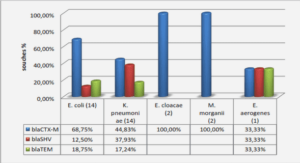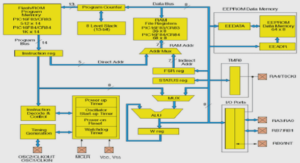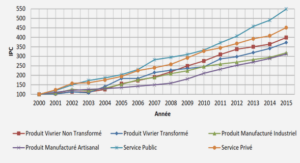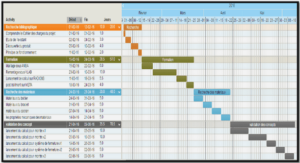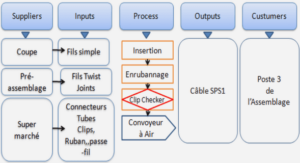PRISE EN CHARGE DES RELIQUATS POST-CHIRURGICAUX DE SCHWANNOMES VESTIBULAIRES
Pathophysiology
Most of the recent understanding of pathophysiological mechanisms responsible for the genesis and growth of VS came from the study of NF2 patients. NF2 gene is located on chromosome 22q12. This gene is expressed at high levels during embryonic development and in an adult’s life, in the Schwann cells, the meningeal cells, the lens and the nerves.
This NF2 gene leads to the production of a protein called schwannomin/merlin (S/M). S/M is a 590 amino-acid protein, related to a family of cytoskeleton-to-membrane protein linkers and has been shown to interact with cell-surface proteins (Figure 3). These proteins are involved in cytoskeletal dynamics and in regulating ion transport as well as motility and growth of the Schwann cells by their interaction with CD44 and RhoGTPases.
The NF2 gene acts as a tumor suppressor gene. Its alteration is the cornerstone of the Schwann cells proliferation and the genesis of VS, leading to the absence of expression, or the expression of a non-functional S/M protein by the Schwann cells.
In non-NF2 patients with a sporadic unilateral vestibular schwannoma, it has been shown that in 60% of cases a gene mutation leading to the production of a non-functional variant of S/M or the absence of its production is observed. In the remnant cases, it may be supposed that the expression of S/M is regulated by epigenetic factors and the action of protein cascades like caspases (4).
Neurologic symptoms
Afterwards the neurologic signs appear. They are caused by the shift and mass effect induced by the VS on the brainstem. Neurological signs like ataxia, gait disturbance, facial function impairment and hydrocephalus may be noticed. Among the neurological signs, the search for cranial nerve impairment is critical and conditions the therapeutic management of VS. For example, Vth cranial nerve impairment will be searched for with the corneal reflex. Its impairment is the sign of an ocular risk with an increased risk of keratitis. VIIth cranial nerve impairment, which is important for the post-operative facial prognosis and surgery, is searched for and quantified using the House-Brackmaan scale (7)(Table I).
Audiometry
Both tonal and vocal audiometries are performed in the audiometric screening. A unilateral perception surdity associated with an early impairment of intelligibility is the main feature observed in VS.The criteria to define and analyze this hearing loss and to guide the therapeutic management decision were defined in the Tokyo consensus. The Tokyo criteria use both the tonal and vocal audiometry to highlight the functional audition (8). The most common feature in tonal audiometry is an asymmetrical high-frequency sensorineural hearing loss (Figure 4).
The Otoneurosurgical period
The Otoneurosurgical period began at the end of the 1950s with the growing implication of Otologists in the diagnosis and treatment of VS. At this time, the diagnosis was refined and made at an early stage with a predominance of otological signs making VS patients “otological patients” rather than neurosurgical patients. This modification in the VS patient recruitment had a direct impact on the therapeutic objectives. VS surgery became more a functional surgery to avoid the appearance of neurological signs rather than a life-saving procedure, the primary therapeutic objective became the removal of the tumor with post-operative functional consequences. Otologists were the first to use peroperative microscopy (11) and they soon suggested transpetrous approaches.
Translabyrinthine approach
The translabyrinthine approach is one of the surgical approaches used nowadays. It was first described by Panse in 1904 and popularized by House with the publication of a group of 53 patients in 1964, with a sharp decrease in mortality and post-surgical facial palsy, with a 7% mortality rate and a normal facial function in 72% of cases in a group of 200 patients in 1968 (15, 16).It is the elective surgical approach for large VS Koos III or IV, with an ipsilateral cophosis (Tokyo score C or worse) because this technique requires drilling the temporal bone and going through the cochlea and the semi-circular canals. Also, procidence of the jugular gulf and pneumatization of the mastoid bone should be assessed prior to surgery, an important procidence or a poor mastoid pneumatization may push the physician towards a retrosigmoid approach (17).For this technique, the patient is placed in a dorsal decibitus position. Then the surgeon performs a retro-auricular incision, followed by a craniotomy by drilling the mastoid bone and the labyrinth. For the translabyrinthine drilling, the borders of the craniotomy are the middle fossa’s dura mater in cranial, 2cm after the bare sigmoid sinus in dorsal, the jugular gulf in caudal and the posterior face of the internal auditory canal in frontal. After opening the dura mater, the facial nerve is identified, the dissection of the VS begins with the cisternal portion with tumor volume regression allowing the physician to gradually continue the dissection of the VS from the facial nerve towards its apparent origin form the pons, and towards the internal auditory canal (18) (Figure 5).The advantage of this technique is to offer a large exposure of the internal auditory canal and a good visualization of the facial nerve without retraction of the cerebellum, making this surgical approach the best option for a complete removal of the VS with optimal facial function preservation.
|
-INTRODUCTION
-METHODS
-RESULTS
-DISCUSSION
-CONCLUSION
-BIBLIOGRAPHY
-TABLE OF CONTENTS
![]() Télécharger le rapport complet
Télécharger le rapport complet

